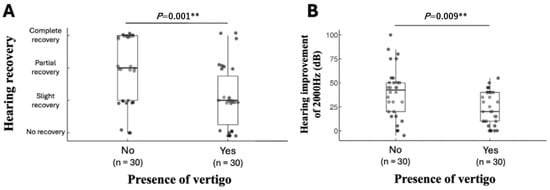- Article
Efficacy of Combined Hyperbaric Oxygen, per Os Steroid, and Prostaglandin E1 Therapy for Idiopathic Sudden Sensorineural Hearing Loss and Prognostic Factors for Recovery
- Takumi Nakayama,
- Satoshi Hara and
- Takeshi Kusunoki
- + 6 authors
Background: Idiopathic sudden sensorineural hearing loss (ISSNHL) is an abrupt unilateral hearing loss of unknown origin. Combination therapy with hyperbaric oxygen (HBO), systemic steroids (SS), and prostaglandin E1 (PGE1) has been used in Japan; however, its prognostic factors remain unclear. Objective: To evaluate the efficacy of HBO combined with SS and PGE1 and to identify prognostic factors for hearing recovery in patients with ISSNHL. Methods: This retrospective study included 116 patients treated within 14 days of ISSNHL onset. Sixty patients received HBO, SS, and PGE1 (HBO group), and 56 received SS and PGE1 alone (No-HBO group). Hearing outcomes were assessed using PTA (arithmetic mean hearing at 250–4000 Hz) and graded by Siegel’s criteria. Prognostic factors were analyzed by multivariate logistic regression. Results: The HBO group showed significantly better hearing grade outcomes (p = 0.007) and greater PTA improvement (p = 0.003) than the No-HBO group. Vertigo and higher initial PTA were identified as independent predictors of poor hearing outcomes. Patients without vertigo showed significantly greater improvement at 2000 Hz (p = 0.009). Receiver operating characteristic analysis revealed an optimal initial PTA cutoff of ≥90.5 dB for predicting poor hearing outcome. Conclusions: HBO combined with SS and PGE1 significantly improves hearing outcomes in ISSNHL. However, the presence of vertigo and severe initial hearing loss remain poor prognostic indicators. These findings suggest that while the addition of HBO may enhance hearing outcomes, prognosis remains limited in severe cases. Further prospective studies are needed to confirm these results.
14 December 2025





